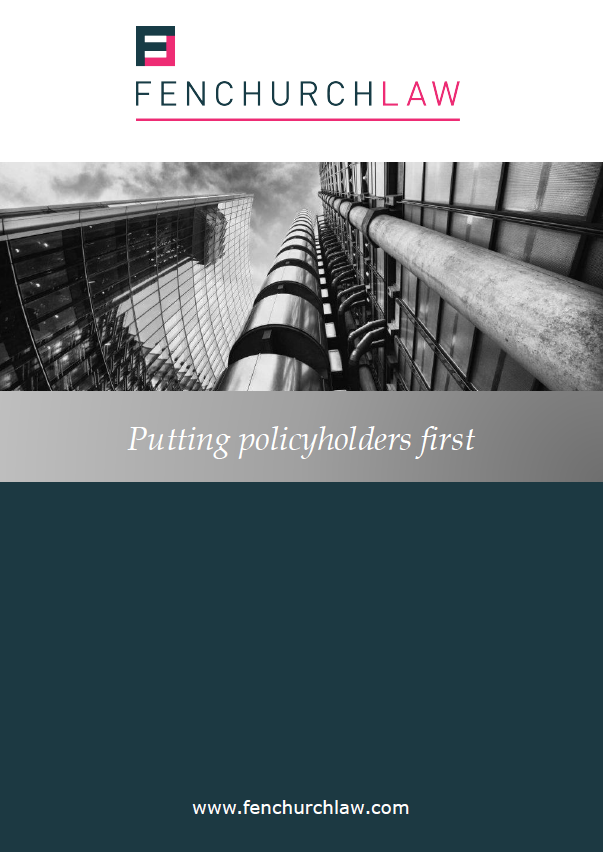
(Not) the new LEG clauses.
Let me start by making something clear. The clauses referred to below are NOT the new LEG clauses.
Whilst I have made no secret of my view that the LEG committee does need to amend LEG3 (and, perhaps, should have done so before now), and that the decisions in SCB and Archer have provided a golden opportunity to overhaul not just the LEG clauses, but the DE clauses too, I have no involvement in the decision about whether the LEG committee will, in fact, produce new versions of the LEG clauses or, if they do decide to do so, in determining what those clauses will look like. As a result, what is set out below represents nothing more than my own suggestions about how the existing LEG clauses could be amended in order to preserve what I believe to be the general market understanding of their meaning, whilst being expressed in clear language that would be easily understood not only by those who specialise in CAR / Builder’s Risk, but also by those who have no involvement in this particularly fascinating area of insurance.
I have been asked, not unreasonably, whether it is misleading of me even to refer to my own draft clauses by reference to the official LEG clauses. However, after careful consideration I have maintained the view that I originally took instinctively, that it is appropriate for me to do so, for two reasons.
The first is that my proposed clauses are not intended to alter the meaning of the existing clauses but, rather, to express what I regard as the meaning of the existing clauses in a clear way. Whilst I am happy to be challenged about my understanding of the meaning of the existing clauses, it would make no sense for me not to explicitly link my drafts to the current clauses, because my re-drafts of each clause only make sense when considered in the context of the original. I don’t consider it to be my place, as a lawyer, to be suggesting that the intention of the existing clauses should be changed in order to provide more (or less) cover. That is for underwriters and brokers to decide.
The second reason is that, although the LEG clauses are officially maintained by the London Engineering Group (i.e. “LEG”), the existing clauses have become, in my view, public property as a result of their popularity, and by their wide usage across the world. For better or for worse, the scope of cover provided by Builder’s Risk policies in every insurance market needs to be considered in the context of the defects exclusions produced by the LEG committee, whether an official LEG clause is used, or whether a different form of defects exclusion is used (whether from the DE suite, or bespoke clauses).
That being the case, it seems to me that anyone with a serious interest in the health of the Builder’s Risk market has the right to contribute to the debate about what the market-leading suite of defects exclusions (which is what the LEG clauses are) should look like in the next generation of Builder’s Risk policies. I don’t claim to have any unique insight into that debate, or to be writing the last word on the subject, but I do hope that what I say can be a useful contribution to what should be a market-wide conversation about these important clauses.
What would be worse even than the unsatisfactory position that we are in today (where SCB and Archer have raised considerable uncertainty about the meaning of the clauses, and arguably called into question whether their meaning can reliably be ascertained at all), would be for insurers to fragment and begin to provide a multiplicity of their own defects exclusions. These clauses have layers of meaning, and there is beauty in their individual and collective complexity. But if we move away from standard defects exclusions, then beautiful complexity may give rise to unfathomable chaos in which brokers, policyholders and, if we’re honest, even the Builder’s Risk underwriters themselves, will have little chance of achieving a clear common understanding of the cover that their policies are providing. In that situation it would only be the lawyers who would be the only winners, and no-one wants that.
So, what is the problem with the existing clauses?
Firstly, they are overly long and convoluted. There are numerous phrases (most notably, but not only, the words in brackets in the 2006 version of LEG3) which I understand to have been introduced “for the avoidance of doubt”, but which have had precisely the opposite effect. Rather than bringing clarity to the meaning of the clauses, these superfluous phrases have instead obscured that meaning.
Secondly, the word “defect” is used to describe two quite different things in different contexts. Sometimes the word defect is intended to describe the condition of the insured property. At other times it appears to be intended to refer to a mistake (whether a mistake concerning design, or workmanship, etc).
Thirdly, the clauses have encouraged some users to take the view that they treat “damage” on the one hand, and a “defect” on the other, as binary concepts, so that one should be concerned with the question of whether insured property is damaged OR defective. However, that is plainly not right. As I remember being explained to me when I began to work with Builder’s Risk policies, when you refer to “damage” you are concerned with a happening, whereas when you refer to a “defect” you are concerned with a condition.
Knowing that insured property is in a condition that the owner would preferred it not to be in, today (so that it can therefore be described as being defective, today), tells you nothing at all about whether the insured property underwent an adverse change in physical condition which impaired the value or usefulness of the property. If it did undergo that change (i.e. it suffered damage in order to reach its defective state or, to put it another way, it become “damaged”), then that would trigger the insuring clause of a Builder’s Risk policy. If, on the other hand, the insured property was simply built badly, it should never trigger the insuring clause of a Builder’s Risk policy.
So, what am I intending to achieve in my proposed re-drafts of the clauses? As set out above I am not intending to suggest any alteration of the cover which I believe is intended by the existing clauses. Rather, my only intention is to express, in as clear language as possible, my understanding of the meaning of the existing clauses.
With that in mind, my re-drafts have largely retained the existing language of the current LEG clauses, and primarily removed the words which in my view serve to obscure the meaning of the existing clauses. The exception to that approach is in my proposed amendment to LEG1, where in order to avoid using the word “defect” to refer to a mistake, I have instead introduced that word into the clause even though it doesn’t appear anywhere in the existing suite of exclusions. However, in my view, the natural and ordinary meaning of the word “mistake” accurately reflects the meaning of the (in my view) misleading word that it replaces in the original clause.
A final point in relation to the clauses. As I explained in my article on the SCB decision, the urgent need to amend LEG3 (and, by extension, the other LEG clauses) presents an opportunity to move away from the current unhelpful position where we have two separate suites of defects exclusions (LEG, and DE).
Each suite can be broken down in three categories: clauses that are concerned with causation (LEG1 and DE1); clauses that are concerned with improvements (LEG3 and DE5); and clauses that are concerned with the condition of the insured property before damage occurred (DE2-4, and LEG2). Of those three categories, the clauses relating to two of them are materially the same in each suite, despite differences in drafting (i.e. LEG1 and DE1 do the same thing, as do LEG3 and DE5 – there may be technical arguments that they operate slightly differently, but those technical arguments should not, in my view, be taken seriously).
The only difference between the two suites is in the intermediate clauses which are concerned with the condition of the property before the damage occurred. In that regard LEG2 operates materially differently from DE2-4. That is due to the different origin of the two suites: the DE clauses were intended to be general Builder’s Risk clauses, whereas the LEG clauses were introduced specifically to cater for engineering risks (i.e. EAR as opposed to CAR). Unfortunately, the DE clauses have not been as successfully exported as the LEG clauses (perhaps because there are more of the DE clauses and so they are perceived as being more difficult to understand), with the result that in some important markets, including the US, the LEG clauses are used as standard for civils projects, whereas the DE clauses would be more appropriate for projects of that type.
So, rather than simply amending the LEG clauses, it seems to me to be much more sensible to introduce a single suite of clauses which are based on the existing LEG clauses, but which re-brand LEG2 in the way it was intended (i.e. as applying to EAR) and amending DE3 as a civils alternative to LEG2.
And with that rather long introduction, and with thanks for the patience of anyone who has taken the time to read this far rather than jumping straight to the draft clauses themselves, here are my suggestions for a new single suite of defects exclusions, modelled on the current LEG clauses, but with an amended version of DE3 introduced as an alternative to LEG2 (and branded LEG2 (CAR)).
| Original clauses | My draft clauses |
| LEG1
“The Insurer(s) shall not be liable for Loss or Damage due to defects of material workmanship design plan or specification.” |
LEG1
The Insurer shall not be liable for the cost of fixing any damage caused by mistakes of any kind. |
| LEG2
“The Insurer(s) shall not be liable in respect of: All costs rendered necessary by defects of material workmanship design plan or specification and should damage occur to any portion of the Insured Property containing any of the said defects the cost of replacement or rectification which is hereby excluded is that cost which would have been incurred if replacement or rectification of the said portion of the Insured Property had been put in hand immediately prior to the said damage. For the purpose of this policy and not merely this exclusion it is understood and agreed that any portion of the Insured Property … shall not be regarded as damaged solely by virtue of the existence of any defect or material workmanship design plan of specification”. |
LEG2 (EAR)
Should damage occur to any portion of the Insured Property which was in a defective condition before the damage occurred the Insurer shall not be liable for the cost that would have been incurred to fix the defects in that portion of the Insured Property immediately before the damage occurred.
|
| DE3
“This policy excludes loss of or damage to and the cost necessary to replace repair or rectify: i. Property insured which is in a defective condition due to a defect in design plan specification materials or workmanship of such property insured or any part thereof; ii. Property insured lost or damaged to enable the replacement repair or rectification of Property insured excluded by (i) above. Exclusion (i) above shall not apply to other Property insured which is free of the defective condition but is damaged in consequence thereof.” |
LEG2 (CAR)
The Insurer shall not be liable for the cost incurred to fix any portion of the Insured Property which was in a defective condition immediately before the damage occurred.
|
| LEG 3/06
“The Insurer(s) shall not be liable in respect of: All costs rendered necessary by defects of material workmanship design plan or specification and should damage (which for the purposes of this exclusion shall include any patent detrimental change in the physical condition of the Insured Property) occur to any portion of the Insured Property containing any of the said defects the cost of replacement or rectification which is hereby excluded is that cost incurred to improve the original material workmanship design plan or specification. For the purpose of the policy and not merely this exclusion it is understood and agreed that any portion of the Insured Property shall not be regarded as damaged solely by virtue of the existence of any defect of material workmanship design plan or specification.” |
LEG 3
The insurer shall not be liable for the cost incurred to improve the original material workmanship design plan or specification.
|
I would love to hear from anyone who either agrees or disagrees with what I’ve set out above. The market would benefit from a debate on this important issue, and we have an opportunity to create a better situation than the one in which we find ourselves today. Please feel free to email me either at david.pryce@fenchurchlaw.co.uk, or at david.pryce@fenchurchlaw.com.sg.
David Pryce is a Senior Partner at Fenchurch Law.
Other news
Singapore’s factory output boom: Is your Business Interruption cover keeping up?
10 December 2025
In the News… is a new blog series from Fenchurch Law that translates today’s headlines into practical insights for…



